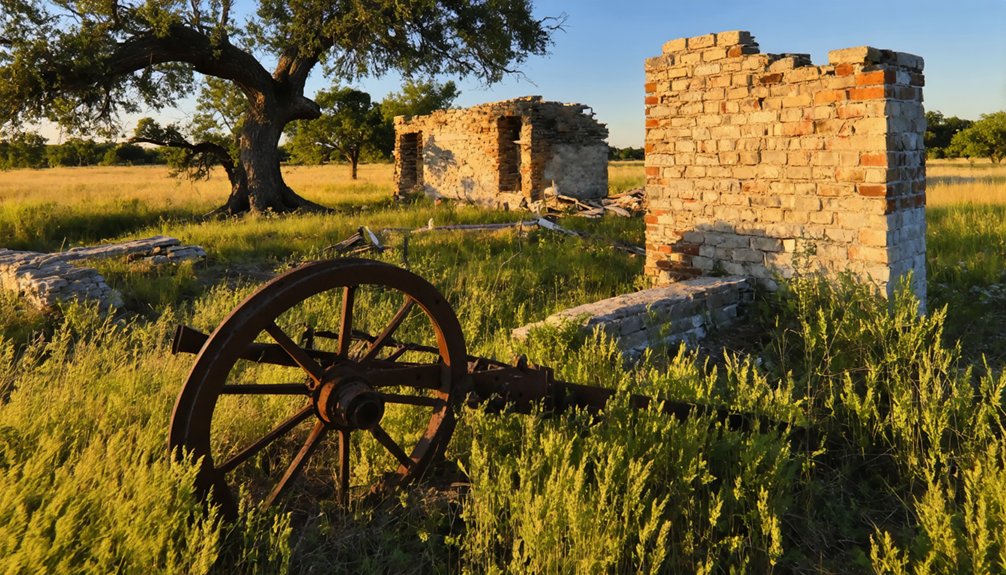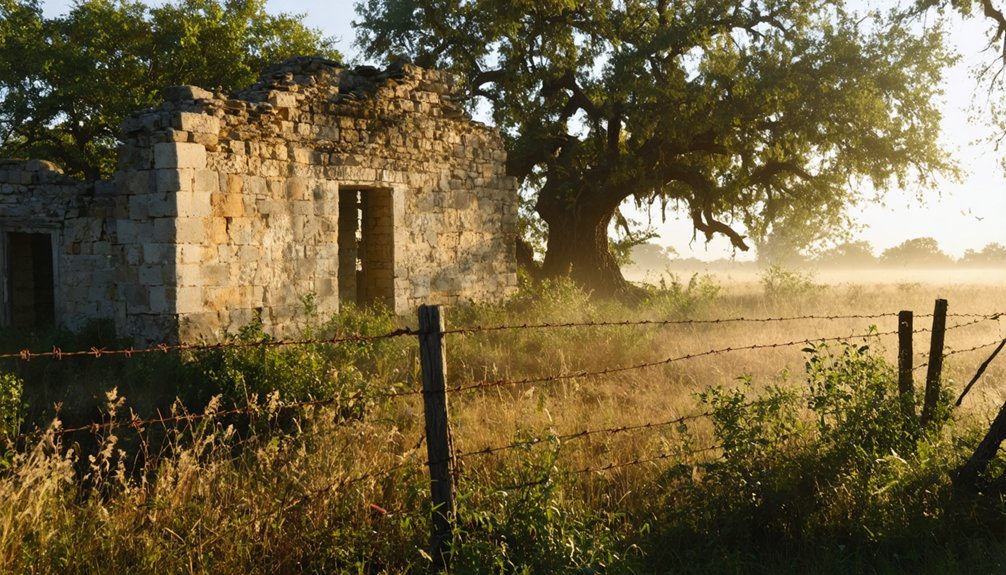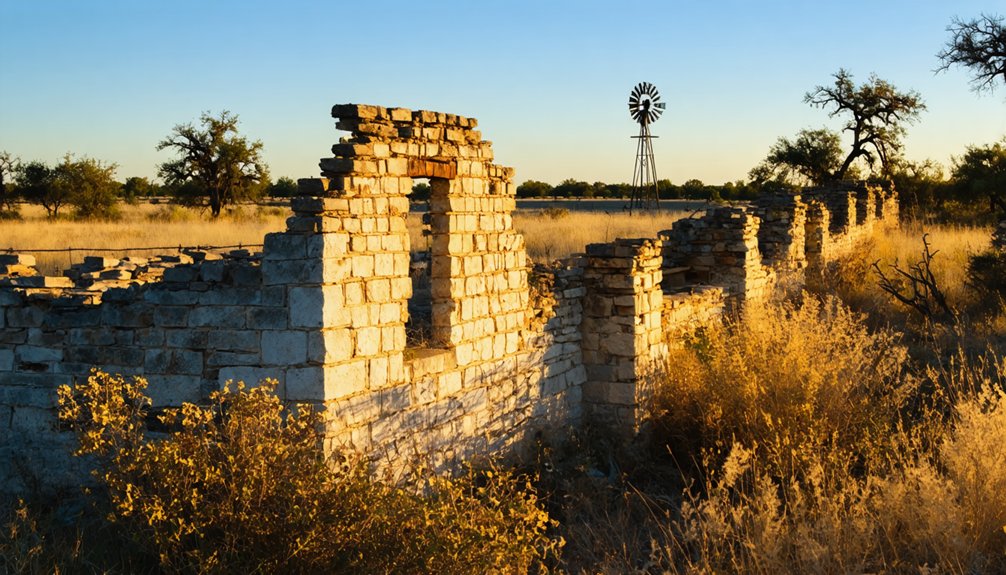You’ll find Sarahville de Viesca‘s remains near present-day Marlin, Texas, where it once stood as the capital of Robertson’s Colony in 1834. Named after Sarah Robertson and Governor Agustín Viesca, this frontier settlement peaked at 200 residents before Indian raids and Mexican forces led to its abandonment in 1836. Fort Milam’s ruins and a stone monument now mark where this essential crossroads community thrived at the Falls of the Brazos. The settlement’s dramatic story reflects early Texas colonization’s harsh realities.
Key Takeaways
- Sarahville de Viesca was founded in 1834 near the Brazos River and reached a peak population of 200 before becoming a ghost town.
- The settlement was abandoned in 1836 during the Runaway Scrape when settlers fled from approaching Mexican forces and Native American raids.
- Fort Milam’s presence couldn’t prevent the town’s downfall despite its strategic location and defensive capabilities against Native American attacks.
- The ghost town’s original location is now marked by a stone monument near present-day Marlin, Texas.
- The settlement’s short-lived existence lasted only two years before complete abandonment, though its historical significance in Texas colonization endures.
The Birth of a Colonial Capital
In 1834, Sterling C. Robertson established Sarahville de Viesca near the falls of the Brazos River, creating what would become a crucial hub of colonial governance in early Texas.
You’ll find the town’s unique name reflects both Robertson’s family heritage and Mexican influence, honoring his mother Sarah and Governor Agustín Viesca of Coahuila y Tejas.
As the capital of Robertson’s Colony, a massive 100 by 200 mile territory, the settlement quickly developed essential community dynamics.
From its central position, Robertson’s Colony transformed 20,000 square miles of wilderness into a thriving frontier community.
The town’s location at a critical stony ford made it an important crossroads for travelers moving between east and southwest Texas.
You’d have witnessed settlers arriving at the town’s land office to secure their property titles, while Fort Viesca provided protection for the growing population.
The settlement flourished, reaching about 200 residents at its peak, marking a significant achievement in Texas colonization efforts despite the challenges that lay ahead.
The town was ultimately forced to evacuate in 1836 when faced with Indian hostilities and the approaching Mexican army.
Life at the Falls of the Brazos
While Sarahville de Viesca served as the colony’s administrative center, the Falls of the Brazos shaped daily life for settlers and Native Americans alike.
You’d find this natural landmark serving as the region’s essential crossroads, where a 10-foot rocky ledge created the only hard-bottom crossing for 200 miles.
Pioneer life here wasn’t easy. You’d face frequent clashes between settlers and Native American tribes, particularly the Waco, Tawakoni, and Anadarko peoples, while Comanches often drove others from the territory. Fort Milam was established to coordinate military operations against hostile tribes in the area.
Many early residents came from Alabama, Tennessee, and Mississippi to settle the land under the empresario system.
By the 1840s, you’d find yourself at Bucksnort, the area’s first trading post east of the river, where blacksmiths worked and supplies were traded.
The falls themselves marked the limit of steamboat navigation, making this location pivotal for both transportation and commerce until an 1866 storm altered the river’s course, forever changing this historic landscape.
Military Presence and Fort Milam
You’ll find Fort Milam’s strategic position on the west bank of the Brazos River made it an essential defensive outpost for protecting settlers in 1834.
The garrison’s operations focused on maintaining security against Native American raids, though these same threats would eventually force its abandonment just a few years after construction. The area experienced a temporary desertion during the Runaway Scrape of 1836. The ruins of the fort now sit near the scenic Brazos River Falls, offering visitors a glimpse into frontier life.
Initially part of the settlement known as Sarahville de Viesca or Bucksnort, the fort’s name honored Benjamin Rush Milam, a prominent figure in Texas’ fight for independence.
Strategic Defense Location
Situated at a strategic ford along the Brazos River, Sarahville de Viesca’s military significance centered around Fort Milam, a robust defensive structure built in 1834 to protect settlers from Native American raids.
After initially being known as Sarahville De Viesca, the settlement underwent a notable change when it was renamed to Milam in December 1835.
You’ll find the settlement’s defensive strategies were carefully planned around natural barriers and tactical advantages:
- The fort’s construction featured 11-foot-high cedar pickets with double banking and bastions at each angle, spanning 150 feet square.
- The falls of the Brazos River provided a natural barrier against attacks while serving as a essential monitoring point.
- The fort’s position on the west bank enabled troops to maintain surveillance over both the river crossing and surrounding territory.
The defensive structure was initially protected by volunteer companies until Company D of the Republic of Texas regulars arrived in August 1839.
This strategic location proved important for frontier defense, allowing volunteer companies and later Republic of Texas regulars to effectively protect settlers and maintain control over this critical territory.
Frontier Garrison Operations
Throughout the Republic of Texas era, Fort Milam served as a crucial military outpost under the command of Colonel Edward Burleson, who initially stationed three Texas Ranger companies to defend against both Mexican forces and hostile Native American tribes.
The fort featured a 150 feet square layout with defensive bastions at each corner. The garrison’s strategies involved deploying detachments to construct additional fortifications, including Little River Fort, Fort Fisher, and Fort Henderson, strengthening the frontier defense network. The fort saw declining military presence when enlistment periods expired in the summer of 1837.
After a brief abandonment in 1837, Captain Joseph Daniels reestablished Fort Milam in 1839 with his Milam Guards company.
The fort’s volunteer forces and regular troops engaged in numerous conflicts with Wacos, Tawakonis, Anadarkos, and Comanches.
Through persistent military operations and strategic patrols authorized by the Texas legislature, you’ll find that these efforts finally brought peace to the region by 1845.
Fort Name Transition
While the site initially bore the name Viesca under Mexican authority, a significant change occurred on December 26, 1835, when the Texas provisional government renamed the municipality to the Milam Land District.
The fort renaming significance reflected Texas’s emerging independence, honoring Ben Milam just 19 days after his death at San Antonio.
You’ll find these pivotal changes in the site’s military heritage preservation:
- The transformation from Viesca to Fort Milam symbolized the shift from Mexican control to Texan sovereignty.
- Captain Joseph Daniels established the fort in 1839, creating a 150-foot square cedar structure.
- The site evolved from volunteer militia control to hosting Company D of the Republic of Texas regulars.
This strategic location near the Brazos River Falls became essential for defending settler interests and establishing Texas independence.
Settlement Challenges and Daily Life

Life in Sarahville De Viesca proved exceptionally challenging as settlers faced constant threats from Indian raids while trying to establish basic community infrastructure.
You’d have found daily routines centered around essential tasks like farming and protecting the settlement, while the land office processed claims for Robertson’s vast colony. Settler cooperation became essential for survival, as you’d need to band together against frequent hostile attacks.
Living at 321 feet above sea level near the Brazos River ford, you’d have participated in a community focused on both opportunity and vigilance.
While the strategic location offered critical transportation access between eastern and southwestern Texas, you’d have relied heavily on Texas Rangers and local militias to defend your homestead, making security concerns a constant part of daily existence.
The Final Days and Abandonment
You’d find Sarahville de Viesca‘s final days marked by escalating threats from both Indian attacks and advancing Mexican forces in 1836.
The settlement’s residents faced mounting pressure as Fort Milam’s protection proved insufficient against the dual dangers, leading to a gradual exodus of the 200 settlers.
The town’s complete abandonment coincided with the Mexican army‘s approach, effectively ending this frontier community’s brief two-year existence as the Robertson Colony’s capital.
Mounting Threats and Unrest
As threats mounted against Sarahville de Viesca in the mid-1830s, the settlement faced a perfect storm of dangers that would ultimately seal its fate.
You’d have found a community under constant pressure from Native American hostilities, while military instability left settlers increasingly vulnerable. Despite establishing Fort Viesca (later Fort Milam) in 1834, the defensive position weakened as Texas Ranger enlistments expired and troops were reassigned.
Three critical factors intensified the crisis:
- Repeated Native American attacks that disrupted daily life and commerce
- Dwindling military protection as Fort Milam’s forces diminished
- The looming approach of Mexican forces that threatened the entire region
With only 200 residents and mounting security concerns, you’d have witnessed the settlement’s inevitable decline into abandonment by 1836.
Exodus During Mexican Advance
When Mexican forces advanced toward Sarahville de Viesca in 1836, the settlement’s final chapter began to unfold during the widespread civilian evacuation known as the Runaway Scrape. The town’s position near strategic Brazos River crossings made it particularly vulnerable to military strategy, amplifying civilian fears as Mexican troops moved closer to the settlement.
You’d have witnessed around 200 residents hastily abandoning their homes and possessions, joining the mass exodus of Texian settlers fleeing eastward. While some initially planned to return, the combination of Mexican military pressure and relentless Native American raids sealed Sarahville’s fate.
Historical Legacy in Modern Texas

Despite its brief existence in the 1830s, Sarahville De Viesca continues to shape Texas’s historical narrative through various modern commemorations.
You’ll find its cultural significance preserved through historical markers, databases, and local community engagement, while its educational impact reaches students studying early Texas colonization.
Today, you can explore this representation of pioneer spirit through:
- A stone monument near Marlin, Texas, marking the original settlement site
- Historical databases and the Texas Almanac, documenting the town’s role in Robertson Colony
- Local community events and tours that bring the settlement’s story to life
The site remains accessible via SH 6 from Reagan, Texas, where you’re free to connect with this pivotal chapter in Texas’s journey toward independence, reflecting the determination of early settlers who shaped the region’s destiny.
Frequently Asked Questions
Are There Any Archaeological Excavations Currently Taking Place at the Site?
No current archaeological excavations are taking place at the site, though nearby excavation techniques have focused on identifying burial shafts without disturbing artifacts, using shallow archaeological methods to protect historical remains.
What Native American Tribes Were Primarily in Conflict With the Settlement?
All’s fair in love and war – you’d have faced fierce opposition from the Comanches, who dominated the conflict history, while Caddos launched deadly raids. The Cherokee’s tribal relations shifted from peaceful to hostile.
Can Visitors Access the Historical Site Location Today?
You can access the ghost town site via State Highway 6 and County Road 223, where you’ll find historical markers and a roadside park, though visitor guidelines are minimal.
Were Any Significant Artifacts Recovered From the Abandoned Settlement?
Drawing a blank here – you won’t find significant artifacts from excavations. Despite the historical context of early Texas settlement, only human remains and grave sites were discovered without cultural items.
What Happened to the Original Settlers After They Fled?
You’ll find that most settlers migrated to nearby safer counties within Robertson’s Colony, while others joined developing towns like Marlin. Ghost town legends suggest some settlers formed new communities along the Brazos River.
References
- https://www.texasalmanac.com/places/sarahville-de-viesca
- https://kids.kiddle.co/Sarahville_de_Viesca
- https://www.hmdb.org/m.asp?m=208474
- https://atlas.thc.texas.gov/Details/5145004592
- https://fortwiki.com/Fort_Milam_(1)
- https://sites.rootsweb.com/~txfalls/Historical_Markers/Historical_Marker_Webpages/HistoricalMarker_SarahvilledeViesca.html
- https://www.tshaonline.org/handbook/entries/sarahville-de-viesca
- https://dbpedia.org/page/Sarahville_de_Viesca
- https://marlintexas.com/falls-county-history/
- https://texashistory.unt.edu/ark:/67531/metapth91050/



